By David M. Fortier
“On 26th April 1944, during a battle for Hill 172.4 (in Moldavia), the enemy counter-attacked 12 times in an attempt to cut our units off from the sides. Comrade Zhezherya, in spite of hostile fire of the enemy, moved ahead and repulsed all counter-attacks with his machinegun. By the evening, however, the handful of brave (Soviet) soldiers was surrounded, even though their courage remained undiminished. In the ensuing battle Zhezherya alone killed 70 Germans with machinegun fire…the encirclement was broken and his gun-crew rejoined the regiment.”
The above was taken from the award given to Guards Sergeant Aleksandr Efimovich Zhezherya. In a two month span in 1944 he was wounded three times, yet never left the field. He was credited with killing 343 German soldiers and repulsing 22 enemy counter-attacks. His weapon, a M1910 Maxim 7.62 watercooled machinegun.
The Russian Model 1910 Maxim machinegun served with distinction through the First World War, the Revolution, numerous small border conflicts, the Second World War, and then with the Red Chinese in Korea. A dependable and reliable weapon, it utilized Hiram Maxim’s basic recoil toggle system. Born in Sangerville, Maine in 1840 Hiram Maxim was originally apprenticed to a coach builder. He was gifted with a wide-ranging inventive faculty which embraced such things as electric lights, gas generating plants, steam and vacuum pumps, and engine governors. After setting up shop in Hatton Garden, one of the more exclusive market areas in London, he spent from 1882 through 1885 patenting every possible way of using a weapon’s own energy to operate itself. At this time all repeating guns were manually operated. Weapons like the Gatling, Nordenfelt, and Hotchkiss gun were all dependent on the muscle power of their operator. Hiram however was able to harness the weapon’s own energy to operate it using what became known as the recoil principle. Using a toggle lock it operated very much like your knee joint. With your knee locked, upward pressure against the sole of your foot is easily checked. However, a sharp rap to the back of the knee while there is pressure on the sole of the foot will unlock the joint allowing the leg to fold. While seemingly simple, it was revolutionary at the time.
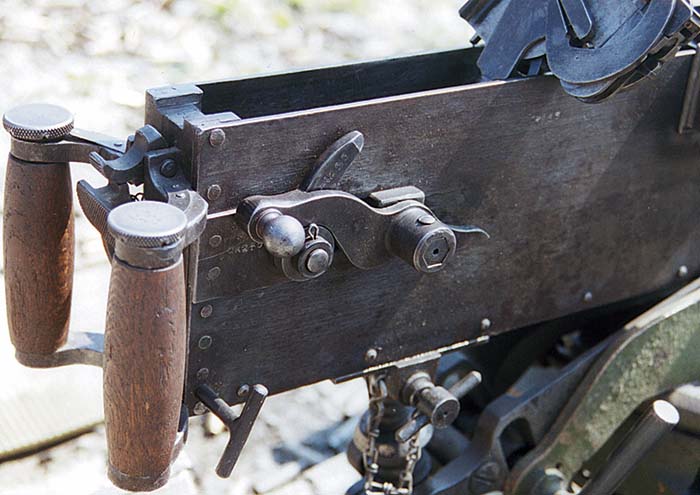
Hiram demonstrated his new invention in front of the Czar in St. Petersburg in 1887. The Russians had been using the Gatling gun since 1865 but had no concept of what true automatic fire was. Looking at Hiram’s invention Russian officers ridiculed it until he sat down and fired 333 rounds in exactly half a minute, shooting the center out of the target. After seeing this Hiram said, “they became enthusiastic”. He promptly received an order for 12 guns in caliber 10.75x58R Russian Berdan for testing and evaluation purposes. Between when Hiram first demonstrated his machinegun in front of the Czar and when their initial order was delivered the Maxim saw its first use in combat. The British where the first to draw blood with it. On 21st November 1888 General Sir Francis de Winton led a command to the newly formed colony of Gambia. Arriving at the fortified village of Robari it is said that the General himself set up the Maxim and opened fire. His dispatch read as follows, “the bullets rained in through the portholes and between the planks killing numbers of the enemy. The breastwork and other towers were treated in the same manner, and in a few minutes it was seen that the garrison were issuing from the fort and flying for their lives.” The abilities of the Maxim were now proven in combat, a small prelude of what was to come.
After Maxim’s M1887 successfully completed trials the Russian Artillery Committee issued a very favorable report. They stated that the automatic machinegun had advantages over all of the mechanical types. Revolving the firing handle of a mechanical gun had required considerable physical strength and quickly tired the gunner so that crews had to be constantly changed. The Maxim eliminated this. The single barrel of the Maxim also brought a substantial weight reduction compared to the multi barrel weapons. Plus a hang fire in a multi-barrel mechanical gun could damage the weapon and injure the crew. An additional advantage was that the cloth belts used by the Maxim were much more convenient than the magazine and cartridge assemblies then in use.
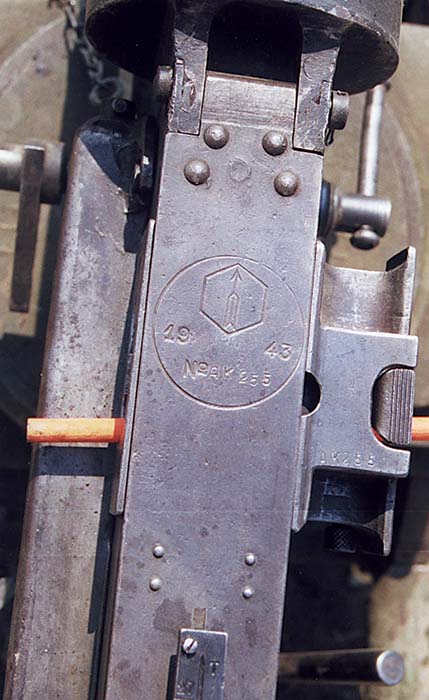
The Imperial Russian Army took delivery of its first automatic machineguns in 1899. Interestingly enough these guns were purchased from DWM in Berlin and were their 1894 Ludwig Loewe commercial model. This was an exact copy of the British 1889 Smokeless Powder Model with heavy brass jacket, early crank handle, 1889 style lock, and was chambered for the “Three-Line” 7.62x54R cartridge. Mounted on large wheeled carriage mounts with gun shields they were issued to the artillery in batteries of eight. Tactical thinking of the time was to deploy them to repulse mass attacks on fortifications and fixed positions. The Russians didn’t have long to wait before they had a chance to use them in combat. Their first use of the Maxim came in the Russo-Japanese War of 1904-05. One such deployment of the Maxim came at the Yalu River where eight Russian Maxim guns stood their ground and beat off several Japanese assaults. The highly motivated Japanese infantry who were accustomed to attacking en-masse were decimated, the Maxim guns stacking their lifeless bodies up like cordwood. They were an immediate success in combat wherever they saw action. The Russians did find out as the war progressed however that the heavy cumbersome artillery style gun carriages did not allow sufficient maneuverability posing the possibility of being outflanked and overrun. Necessity being the mother of invention, the Russian gunners took it upon themselves to improvise expedient mounts out of materials on hand to increase their weapons maneuverability and effectiveness. Later, during World War I the Germans would also make expedient trench mounts for their MG 08’s in an attempt to increase their portability.
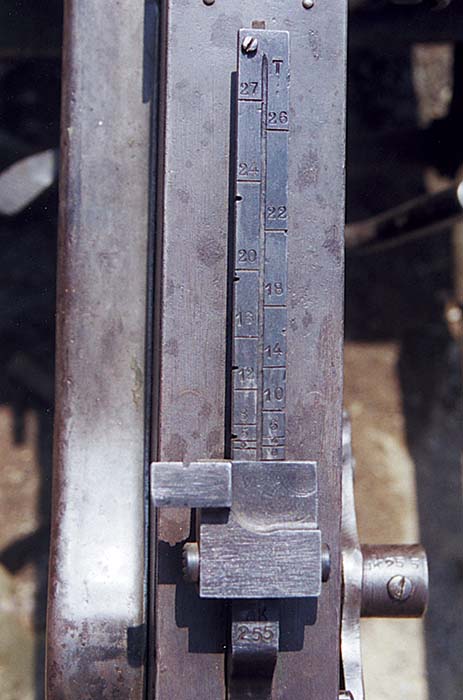
While the war ended in defeat for Imperial Russia it was of no fault of their Maxim guns. Over half of the Japanese casualties were officially credited to Maxim gun fire. Satisfied that it was superior to the Hotchkiss machineguns fielded by the Japanese the Russians decided to begin manufacturing it in quantity to equip their forces with. The first Russian manufactured Maxim was called the M1905. While closely resembling the 1894 Ludwig Loewe Model (Bolotin refers to this gun as the Russian M1895, this may be when the Russians officially adopted it, Goldsmith refers to it as the M1899 as this was the year the Russians actually received them) the Russians incorporated 2 major improvements. These were a new easily field stripped lock (as introduced on the 1901 “New Pattern” commercial Vickers-Maxim), and an “S” shaped crank handle. The M1905 was in turn modernized and replaced by the M1910. This new improved model was basically a fluted jacket copy of Vickers, Sons & Maxim’s “new light” Model of 1906. The heavy brass parts of the earlier guns having been replaced by steel, the M1910 weighed 10-12 pounds less than the previous models. It was mounted on a sturdy wheeled mount that had been designed by Aleksandr Alexeevich Sokolov. The Sokolov mount was an extremely stable firing platform, and could be towed by the gun crew via a rope while traveling on a road. During the winter the wheels could be removed and replaced with ski’s. The Sokolov mount shows a striking similarity to the Vickers commercial combination tripod/wheelmount. While a stable firing platform, the Sokolov mount did have one serious drawback, its weight. The early mounts which incorporated a set of folding legs to allow firing over parapets tipped the scales at a whopping 110 pounds! Later simplified mounts that did away with the extra legs still weighed in at a hefty 80 pounds. A simpler and lighter mount designed by Ivan Kolesnikov was adopted in 1915. However it did not replace the Sokolov mount but merely served alongside it in smaller quantities.
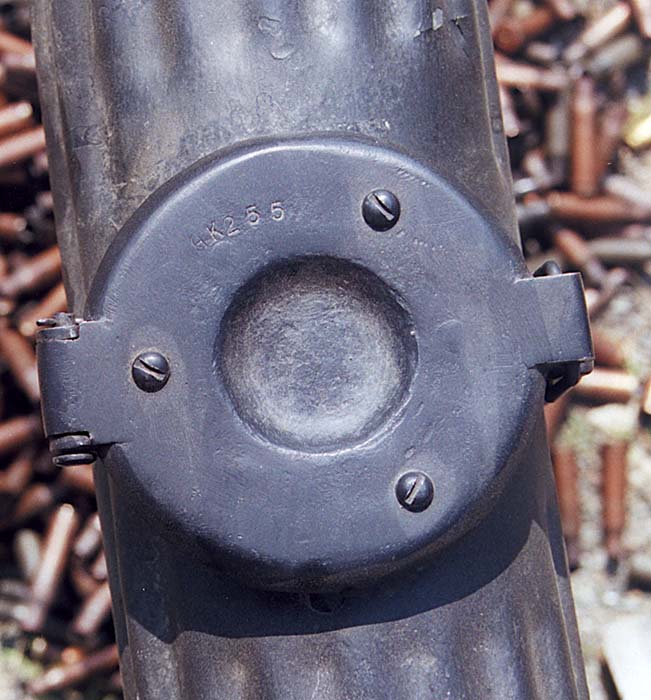
The M1910 Maxim proved to be a tough, sturdy weapon with excellent reliability, even in the muddy conditions of trench warfare during World War I. Yet even the firepower of the Maxim could not make up for the inept senior officers of the Imperial Russian Military. Common German propaganda photos taken during the war show Russian prisoners towing their M1910’s into captivity. During the war the Sokolov mount was simplified by doing away with two extra legs that could be used to raise the gun for firing over a parapet. The excessive weight of the weapon system was also noticed. The guns and early mounts tipped the scales at a none to amusing 155 pounds, while the later mounts lightened the combination up to 125 pounds. To the gun crew desperately trying to wrestle their weapon forward over mud clogged terrain to support their comrades in attack the gun’s weight was a serious drawback. It’s no simple feat to scramble forward with your Mosin-Nagant under interlocking MG 08 fire with 77 cm shells bursting around you. To do it with a 45 pound (not including water) M1910 on your shoulder with its jacket full of boiling water, a steam plume belching out to mark your position, knowing you have to keep up with the attack to provide suppressive fire must have been something else all together.
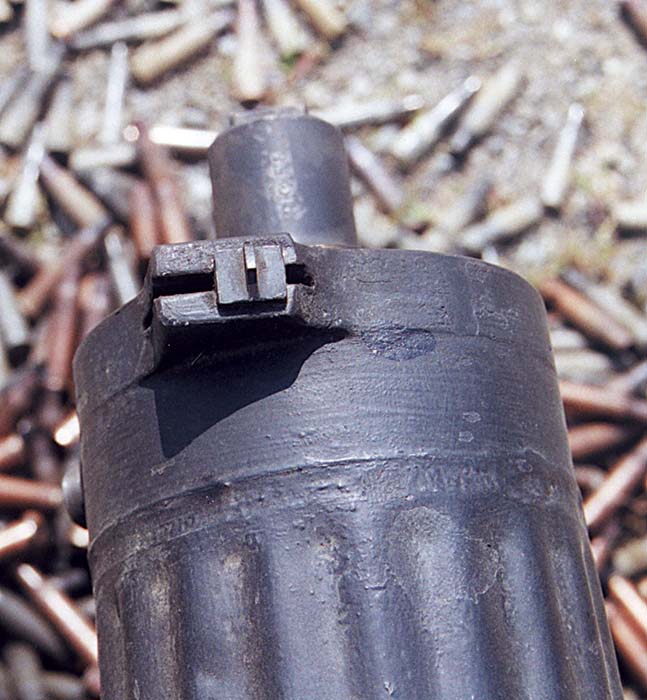
The M1910 fought on both sides during the Revolution and was adopted by the Red Army afterwards. An interesting note is that it was even successfully used by mounted troops during the Revolution. Mounted on a special cart it gave the cavalrymen increased firepower and flexibility. During the 1920’s an attempt was made to lighten the M1910 so as to produce a light machinegun version. Ivan Kolesnikov and Fedor Tokarev both produced lightened air-cooled versions of the basic Maxim. Equipped with a bi-pod and shoulder stock they remind one of the Browning 1919A6. While Tokarev’s design was adopted, it was only produced in small quantities and, due to inherent problems, was subsequently withdrawn from service.
To increase the long-range and indirect fire capabilities of the weapon a new 7.62x54R load was introduced into service. The M1930 Heavy Bullet Type D load consisted of a 182 grain boattailed projectile whereas the normal M1908 load utilized a 148 grain projectile. The new bullet was designed by Dobrzansky and Smirnsky and was intended to increase the effective range out to 4500-5000 meters. It can be identified by a yellow tip (Light Ball was identified by a silver tip). This load was along the lines of the British .303 Mk 8Z ball round designed for long range use with the Vickers MK I. While the 7.62x54R cartridge continues to give excellent service with the Russian Army today, both the M1908 and the M1930 Heavy Bullet loads are officially obsolete. Although officially replaced in Russian service by more modern steel core loads large stocks still exist and may be encountered in odd places around the world.
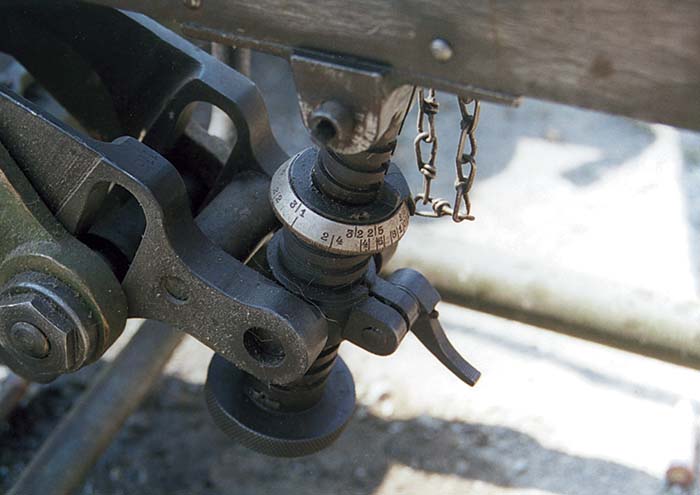
With war looming on the horizon the Soviets were eager to replace the M1910 with a lighter, more modern weapon. While the development of a new HMG had been desired since 1925, such was not to be. As the Wehrmacht blitzkrieged into the Soviet Union Ivan Lubenets and Yury Karazin developed a simplified version of the M1910. Using accumulated combat experience, including lessons learned during the 1939-40 Winter War with Finland, they improved and simplified the Maxim to increase production and eliminate any superfluous features. A new simplified rear sight was installed which lacked the lateral adjustment scale and range graduations for the M1908 Light Ball load. The new rear sight was graduated for the Heavy Bullet load in 100 meter increments out to 2700 meters. It was recognized that the Maxim was normally used to engage targets at ranges up to 800-1000 meters, at these distances the difference in trajectory between the two loads was not great. The original small diameter barrel jacket filler cap was replaced with an enormous one. This allowed the coolant to be refilled much more rapidly. But more importantly it allowed snow and ice to be poured into the jacket. This was useful in the long, bitterly cold Russian winters and was a trick learned the hard way from the Finns who had incorporated this feature on some of their Model 09/32 Maxim guns. Weapons intended for Army service had the optical sight bracket removed. Plus a high pressure aluminum alloy casting replaced the machined steel feed block.
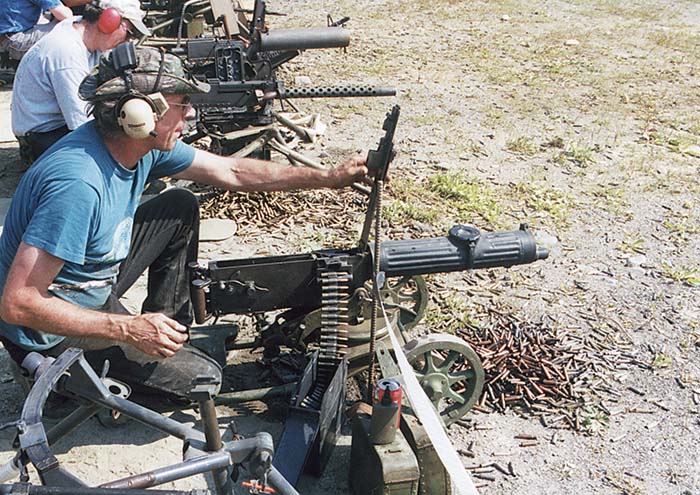
Yet even with constant improvements and good combat characteristics some of the Maxim’s fundamental drawbacks were impossible to eliminate through modernization. The speed of war had changed dramatically since Hiram had originally designed it. Its excessive weight was a significant drawback. The gun and mount were 20-25 kg heavier than its foreign rivals. The water-cooling was a hindrance to combat readiness, especially in temperatures below freezing. Also the barrel jacket was vulnerable to damage from small arms fire and shell fragments. A puncture in the water jacket would severely curtail the sustained fire ability of the weapon.
The Ukrainian Front issued a report on Soviet Artillery Equipment that had this to say, “Maxim 7.62 machinegun is quite satisfactory in regard to its reliability and stability; it is durable and can deliver powerful fire. It is trusted by the soldiers. However, its weight (70 kg) renders the system totally ineffectual; it reduces maneuverability, forcing the crews to lag behind their units in offensive battles and sometimes leaves the attack without fire support. Experience with the combat application of heavy machineguns during the Patriotic War shows that all machineguns weighing more than 40 kg(88 pounds) are a burden in an offensive and thus do not meet combat-maneuver requirements.” And so the venerable Maxim Model 1910 machinegun was replaced in Soviet service after 1945. Many wound up in China and saw action in Korea, and I’m sure some made their way to Vietnam. Then the old war horse faded into the history books, the days of watercooled machineguns being past.
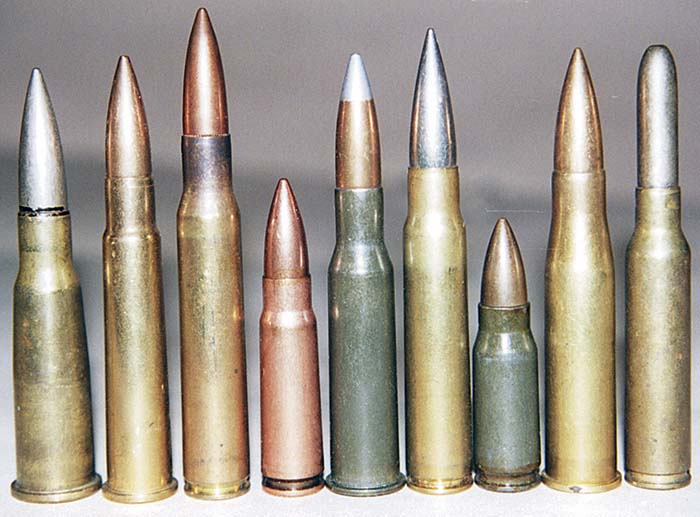
At the 1999 Hiram Maxim Machinegun Shoot in Dover Foxcroft, Maine I had a chance to meet Robert E. Naess and his 1943 vintage M1910 Maxim. Manufactured at Tula Arsenal his M1910 is an excellent example of a wartime production Russian Maxim. Exhibiting a rough finish with unground rivet heads it was not the prettiest thing you ever saw. However there’s just something about holding onto a set of spade grips attached to a watercooled machinegun. It kind of reminded me of a 1968 Plymouth Hemi Roadrunner. With dog dish hubcaps and a spartan taxi cab interior it wasn’t much to look at, but it wasn’t made for looking at, it was made for driving and driving hard. Simply flooring the gas and opening those two enormous 4-barrel carburetors would instantly bring a smile to ones face (and a look of terror to your passengers). So it was with the rough wartime finish M1910. With a belt hanging out of the weapons right side I snapped the crank handle forward twice and with my elbows resting on the inside of my knees I gripped the spade handles. Pushing the safety out of the way with one thumb I pushed the trigger forward with the other. Immediately the old Maxim roared to life spitting 7.62 rounds down range. The crank handle slapped back and forth as the belt danced, indexing through the weapon. A steady flow of empty 7.62x54R cases spilled from the ejection port as 148 grain Light Ball rounds pounded a car down range. At the 100 yards we were shooting at, a 148-grain 7.62x54R projectile is still traveling at 2477 fps for 1919 ft-lbs of energy. It was obvious an automobile was poor protection against a belt fed watercooled machinegun!
Accuracy was surprising. Robert said that with a Finnish made barrel in the weapon it would group into 1 1/2 feet at 450 yards. He feels the Finnish barrels are of superb quality while the Russian barrels tend to be much poorer. While fabric belts were originally used with the Maxim we had no problems using metal non-disintegrating link belts for the Finnish Maxim or metal Goryunov belts. We discussed the subject of fabric belts and how they could affect the weapon’s reliability due to shrinkage from becoming wet. As the belts shrink the pockets grip the cartridges much tighter than normal which can lead to malfunctions. It was his opinion that the 7.62x54R cartridge has a different recoil impulse than the 7.92×57 round. He feels this difference makes the 7.62 guns slightly more reliable when feeding cloth belts.
I was very impressed with the Maxim M1910. My time behind it came to an end much to soon. The weapon exhibited excellent firing characteristics and the Sokolov mount was a very stable firing platform. It was easy to see why the weapon inspired confidence. But of course I didn’t have to pack it about on my back either! For someone interested in owning a Maxim M1910 Robert Naess is currently building them from original Russian parts and registered MG 08 sideplates. For more information and current prices give him a call. For the Imperial Russian/Soviet collector, or the person who just has always wanted a belt fed watercooled machinegun, this might be just what you’ve been looking for.
Postscript: Aleksandr Efimovich Zhezherya was killed in action in one of the last battles of the Great Patriotic War. He was awarded the title of Hero of the Soviet Union and included in perpetuity in the roll of honor of the 1st Company of his Motorized Guards Infantry Regiment. His Maxim M1910 machinegun is now preserved in the Central Museum of the Armed Forces of the USSR.
Acknowledgments: Thanks to Robert E. Naess for his help, knowledge, patience, and time spent behind his 1943 M1910 Maxim.
| This article first appeared in Small Arms Review V3N8 (May 2000) |










